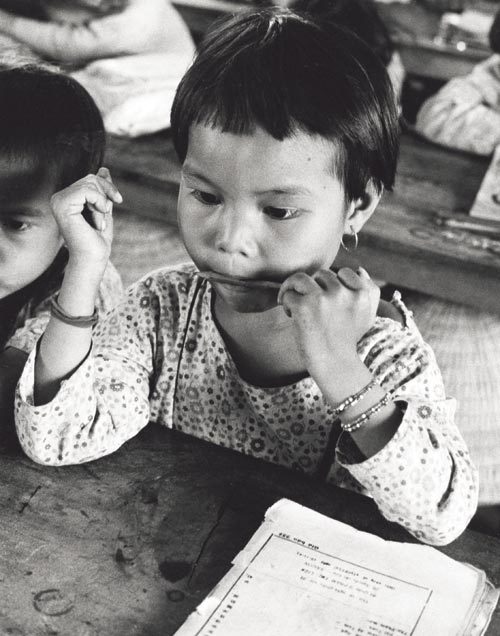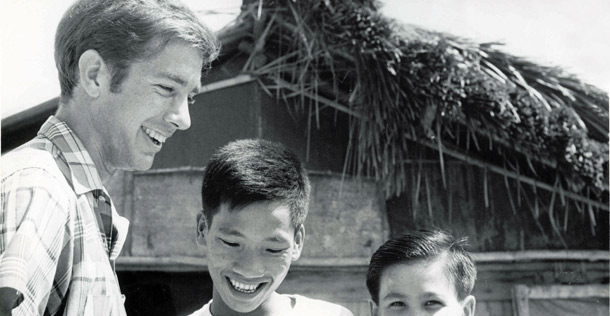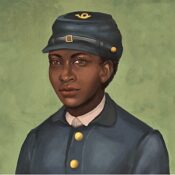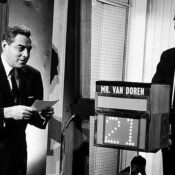 This article and other features about America in Vietnam can be found in the Post’s Special Collector’s Edition, The Heroes of Vietnam. This edition can be ordered here.
This article and other features about America in Vietnam can be found in the Post’s Special Collector’s Edition, The Heroes of Vietnam. This edition can be ordered here.
Originally published December 3, 1966.

to recruit volunteer teachers to help refugees learn to read and write. (Courtesy Doug Hostetter)
—Originally published in Fellowship magazine, Spring 2014—
“The path of return continues the journey.”
—Thich Nhât Hanh
Soon after graduating from Eastern Mennonite College in Harrisonburg, Virginia, I volunteered to do my Alternative Service as a conscientious objector … in Vietnam, working for the Mennonite Central Committee (MCC) in the middle of the war zone, in the middle of the Vietnam War. I understood that as Mennonites we recognized no one as our enemy, and were called to use love and truth as our weapons in the struggle to build a just and peaceful world.
Our Mennonite vision of the world clashed sharply with the vision of our government. The U.S. government designated the North Vietnamese government and the guerrillas active in South Vietnam as the enemy. When I arrived in 1966, hundreds of thousands of U.S. military personnel were already deployed on the air, land, and sea in and around Vietnam.
I was sent to Tam Ky, a village in Quang Tin province in central Vietnam, about 100 miles south of the Demilitarized Zone. Two years before I arrived, the U.S. military had lost control of most of Quang Tin province. With the exception of Tam Ky and two other small towns near the coast along Route 1, the NLF controlled the province. The U.S. military strategy at the time was to drive the civilian population out of the areas controlled by the NLF and into the towns controlled by the U.S. military and the Saigon government. When I arrived in Tam Ky in late 1966, it was teeming with refugees.
My mission was to try to find what the refugees in Tam Ky needed and then help them to get it. To my surprise, the refugee families wanted most for their children to be able to read and write. I was teaching English in several of the high schools in Tam Ky while developing my Vietnamese language skills well enough to be able to do something more productive. It was obvious to me that I was ill-equipped to teach literacy in Vietnamese. If I were going to organize classes for these refugee children, I would need to find local Vietnamese to be the teachers. I was able to use contacts in the high schools to find students who would be willing to work as volunteer teachers for classes of refugee children, starting at first on weekends and summer vacations, and later expanding to full-year classes. The program was quite successful. By the end of my three years in Tam Ky, we had 90 high school students teaching over 3,000 refugee children how to read and write.

Tam Ky was in the middle of the I Corps Tactical Zone, the much-fought-over northernmost military section of South Vietnam. I remember the briefing given to me by the CIA when I first came to Tam Ky. The agent explained, “You can go a kilometer east or a kilometer west of Tam Ky. Beyond that, you are in V.C. territory. We control Route 1 north and south of Tam Ky during the day, but at dusk, that also reverts to V.C. control.” The U.S. government officials and military officers in Tam Ky all lived in heavily guarded military compounds with guard towers, encircling high walls topped with barbed concertina wire and protected by land mines.
I rented a small bungalow in the center of the village. It was just across the street from a high school where I taught. When I first moved in, my landlady told me, “The National Liberation Front often takes over Tam Ky. I have only a four-foot wall around the house, but if you get yourself a few rolls of concertina, a sturdy steel gate, and a .50-caliber machine gun for the front yard, you should be able to hold off the NLF until the Marines can come and rescue you!” I explained to her that Mennonites not only do not use weapons, we don’t even set up defenses for ourselves. “We try to trust God and live at peace with all peoples,” I said. I did put up a sign with a peace dove, a cross, and the name of our organization in Vietnamese so people would know where I lived. But I never put a gate in that four-foot wall, and everyone knew that I owned no weapons.
During my three years in Tam Ky, the NLF did take over the village about a dozen times. Usually the takeover would be for only an hour or so in the middle of a moonless night after a brief exchange of fire with the local Army of the Republic of Vietnam (ARVN) soldiers of the Saigon government. During the Têt Offensive in 1968, however, the NLF, likely with the help of some North Vietnamese soldiers, took over and stayed in Tam Ky for more than a week. It was always very frightening during a takeover. There would be a firefight in the street, and you could clearly hear the ARVN soldiers firing their U.S.-manufactured M-16 rifles and the NLF guerrillas firing their Russian-made AK-47 rifles. People in their homes would crawl into a bomb shelter if they had one, and if not, get on the floor and stay as low as possible. After some time, there were usually fewer shots from M-16s, and more from the AK-47s, and finally the M-16s would disappear completely, and we knew that the NLF was in control of the streets of Tam Ky. The NLF always attacked the military compounds where U.S. government–related officials stayed: the U.S. Agency for International Development, the Military Advisory Command–Vietnam headquarters, and the “U.S. Embassy” compound where three or four CIA agents lived. The MCC staff were the only Americans who chose not to live in a military compound, and although easily accessible, our house was never attacked.
It is fear that drives much violence. In combat, soldiers often kill out of fear of being killed. When a peacemaker renounces weapons, and even the ability to defend himself, it can diminish the fear that propels violence — yet volunteers in Vietnam knew that commitment to nonviolence was never a guarantee of safety. Three pacifists lost their lives during the Vietnam War: Daniel Gerber, a Mennonite, was abducted in Buôn Ma Thuôt, Vietnam, 1962, and never heard from again; Ted Studebaker, from the Church of the Brethren, was killed in Di Linh, 1971; and Rick Thompson, a Quaker, died in a plane crash in Quang Ngai, 1973. In the end we knew that our survival depended on common sense, careful planning, and God’s grace.
Despite my good intentions, and my attempt to make wise decisions on the best advice from my most trusted friends, I did feel vulnerable. I realized that I looked very American to most Vietnamese, and I was in the middle of a combat zone in the middle of an American-initiated, ill-fated war against the people of Vietnam. I was greatly thankful for God’s protection during my time in Tam Ky, and quite frankly, at the end of my three-year assignment, I felt relieved and a little guilty that I had survived a war in which so many friends had died.

Three years ago, one of the high school students who had been a teacher in my literacy program in Tam Ky emigrated to the U.S. He came to visit me in New York. We caught up on old friends, and he filled me in on what happened in Tam Ky when the war finally ended in 1975, six years after I had returned to the U.S. I learned of many mutual friends who had died, and others who had survived, during that long and difficult war. But perhaps the most surprising bit of information was this: I had had a guardian angel.
Le Dinh Sung, an artist who lived in Tam Ky, had been an advisor and my closest friend while I was there. I had been introduced to his younger sister and his mother, and I knew that his father had been killed by South Korean troops working with the U.S. military, but he had never mentioned a brother. When the war ended, neighbors discovered that Le Dinh Sung’s older brother had been a high-level official in the NLF during the war. At war’s end, he was given the top position in the new government of the province. When I learned this information from my former student, I realized that my closest friend in Tam Ky was probably in regular touch with his brother in the National Liberation Front, and that God may have had some help in protecting me when the NLF took over Tam Ky.
Postscript: As director of the Mennonite Central Committee’s United Nations office, the author returned to Vietnam in January 2013, invited as part of a group of U.S. anti-war activists to come to Hanôi to commemorate the 40th anniversary of the signing of the Paris Peace Accords. While in Vietnam, he returned to Tam Ky. Le Dinh Sung had passed away by that time, but he reconnected with two of the artist’s children who are now grown and have children of their own.
Become a Saturday Evening Post member and enjoy unlimited access. Subscribe now



